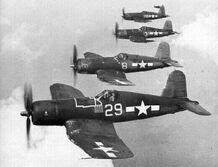The Vought F4U Corsair was a single-seat, carrier capable, fighter that was used by the United States during World War II and the Korean War.
Description
It was powered by a Pratt and Whitney R-2800 Double Wasp engine and it had a top speed of about 683.9 km/h.[1] The first production model was the F4U-1 Corsair and it had an armament that consisted of six 12.7mm MGs mounted in the wings.
The Corsair could also carry 907 kg of bombs or 4 anti-aircraft rockets. The total combat weight of the F4U was 4074.1 kg empty and about 6350 kg fully loaded.[2] It had a total length of 10 meters and a maximum range of 1,633 kilometers. The service ceiling of the Corsair was about 11,247 meters while the rate of climb was 9.5 meters per second.
Reliability of the Corsair was rated as good and demand for the aircraft soon rose to levels above the manufacturing capability of the Vought Company so many began to be produced by other companies such as Brewster.[3] The Corsair was by far superior to many of its Japanese counterparts such as the "Zero" or "Oscar" fighters.
Variants
The F4U Corsair had several variants made throughout its service life. The first of these variants was the F4U-1A. The F4U-1A Corsair had the same 2,000 hp engine as the original and it had a slightly higher altitude ceiling of about 11,200 meters. It could carry around 900 liters of fuel and it weighed about 4,082 kg empty. It also had other modifications such as a raised cockpit and clear-view canopy.[4] The F4U-1B was the same as the traditional F4U-1 Corsair only it was developed and shipped to Great Britain and thus redesignated the F4U Mk I. The F4U-1C however was used by the United States and equipped with four powerful 20 mm canons to combat more advanced Japanese aircraft.[5]
The F4U-1D acted as a fight-bomber and was equipped with a more powerful Pratt and Whitney R-2800-W8 Double Wasp engine. There was also around 1,370 of them produced. The F4U-P1 was again like the F4U-B1 Corsair a basic F4U-1 Corsair fighter only now it was modified to be a reconnaissance plane. The F4U-2 was a special, carrier adapted, nightfighter aircraft that was based on the F4U-1.

F4U-1 Corsairs
The F4U-4 Corsair had a Pratt and Whitney R-2800-18W Double Wasp engine and a top speed of about 717 km/h. It also could have up to eight rockets loaded and had a total weight of about 4,175 kg. The main difference the F4U-4 had from the rest of the Corsairs was that it had a new, faster engine for far better performance. It was the last version produced in WWII and it would be succeeded by the F4U-5 for later use.
History
The F4U Corsair was at first designated the Vought XF4U and as the name says it was produced by Vought. The Corsair was the first carrier based craft to reach a speed of over 400 mph. However it had several problems at first with the decks of US aircraft carriers, so it was released to the Marine Corps. This was mainly caused because the US Navy already had the F6F Hellcat which was a proven fighter. This is where the F4U began producing enemy plane kills. Notably, it wasn't until around 1944 that the Corsair was finally issued to be launched by aircraft carriers. In total, around 12,000 examples had been produced throughout the aircraft's service length.
Captured examples
Originally operated by 1841 Squadron FAA[6] as JT404, F4U-1A BuNo 56187 crashed at Sorvaag during an anti-submarine patrol off Norway with FAA Barracuda Jul 17, 1944.[7] The pilot, Lt Mattholie, was taken prisoner, and the aircraft captured intact with no damage. The German authorities made attempts to get the pilot to explain how to fold the wings so as to transport the aircraft to Narvik. Aircraft was ferried by boat for further investigation. It is not known if the Corsair was taken to Germany. This was probably the first Corsair captured by the Germans. Aircraft is listed at Rechlin for 1944 under repair.[6]
References
- ↑ http://www.militaryfactory.com/aircraft/detail.asp?aircraft_id=87
- ↑ http://militaryhistory.about.com/od/worldwariiaircraft/p/f4ucorsair.htm
- ↑ http://www.warbirdalley.com/f4u.htm
- ↑ http://www.olive-drab.com/idphoto/id_photos_fighters_f4u.php
- ↑ http://www.wwiivehicles.com/usa/aircraft/fighter/vought-f4u-4-corsair.asp
- ↑ 6.0 6.1 http://www.ww2aircraft.net/forum/old-threads/germany-capture-f4u-1a-145.html
- ↑ http://www.joebaugher.com/navy_serials/thirdseries6.html
| ||||||||||||||
